The Franciscans in Medieval Ireland: Sources / Creevalea Franciscan Friary, County Leitrim
- Elaine Harrington
- March 21, 2023
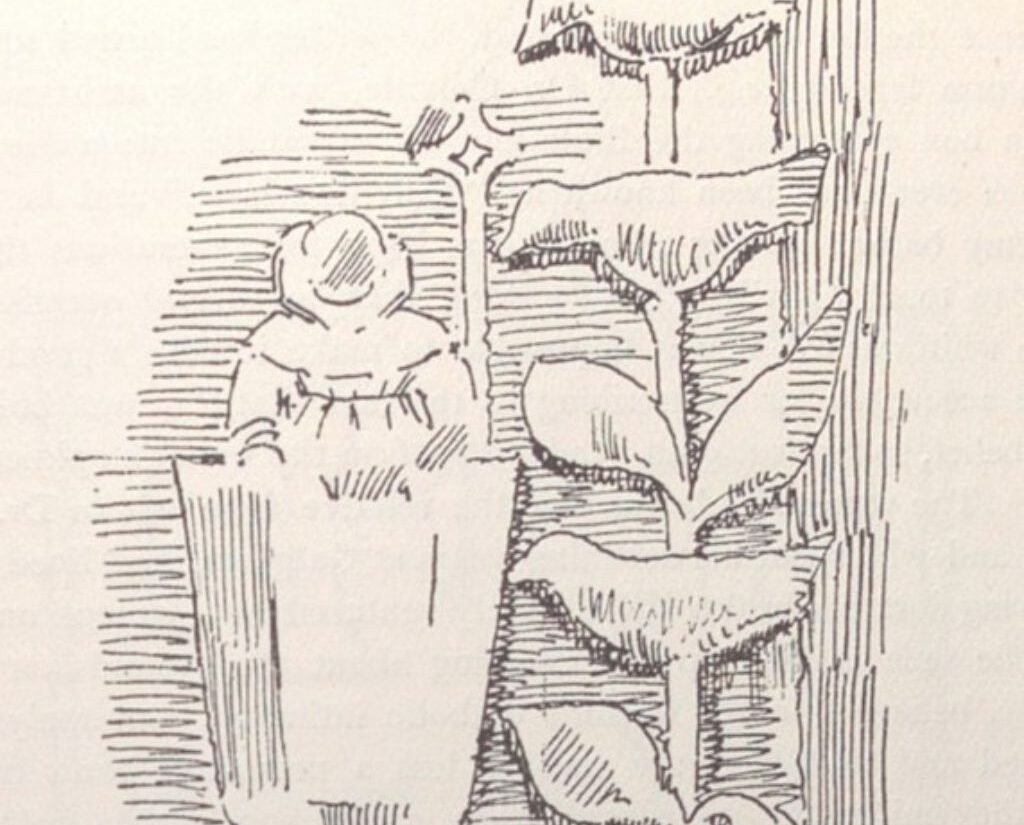
Student Exhibition, MA in Medieval History
Creevelea Franciscan friary is located near the river Bonet on the north-western side of the village of Dromahair in Drumlease-Killargue parish, in County Leitrim. Its foundation dates to the early sixteenth century, making it one of the last Franciscan friaries to be established in Ireland before the dissolution of the monasteries by Henry VIII.
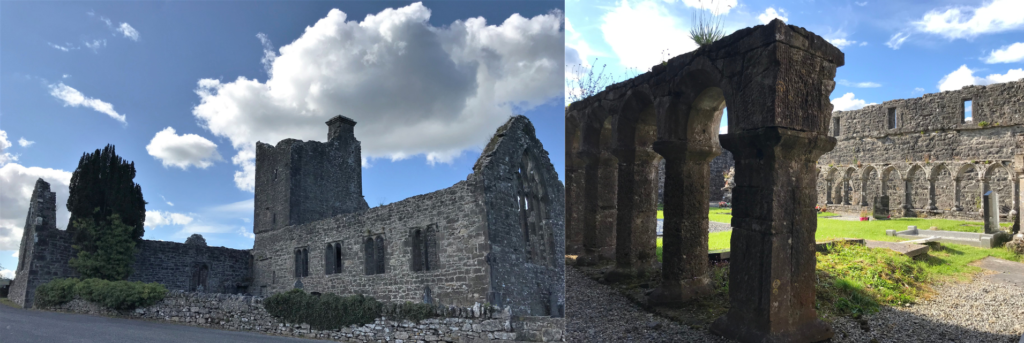
Most early modern sources agree that the friary was founded in either 1508 or 1509 by Margaret O’Brien as a sole founder, or by Margaret and her husband, Eoghan O’Rourke. The Annals of the Four Masters compiled between 1632 and 1636, were translated into English by the historian John O’Donovan and published in 1856. Under the year 1508, the Annals read that the friary of O’Rourke town (Baile-Uí-Ruairc), also called Carrickpatrick, was commenced by Eoghan (Owen) O’Rourke and his wife Margaret O’Brien.

Francis O’Mahony (Matthews), who was the Irish Franciscan Provincial between 1626 and 1629, in his history of the Irish Province (Brevis Synopsis Provinciae Hiberniae FF. Minorum) states that the friary, referred to as the convent of Balliniairck and known as Petra Patricii, was founded in 1508. Mícheál Ó Cléirigh (c.1590–1643), another seventeenth-century Franciscan historian, in the chronological list of Franciscan foundations in Ireland similarly gives 1508 as the foundation date and Margaret as the founder. James Ware (1594-1666) in his De Hibernia et antiquitatibus eius confirms Margaret as the founder, but gives 1509 as the foundation date.
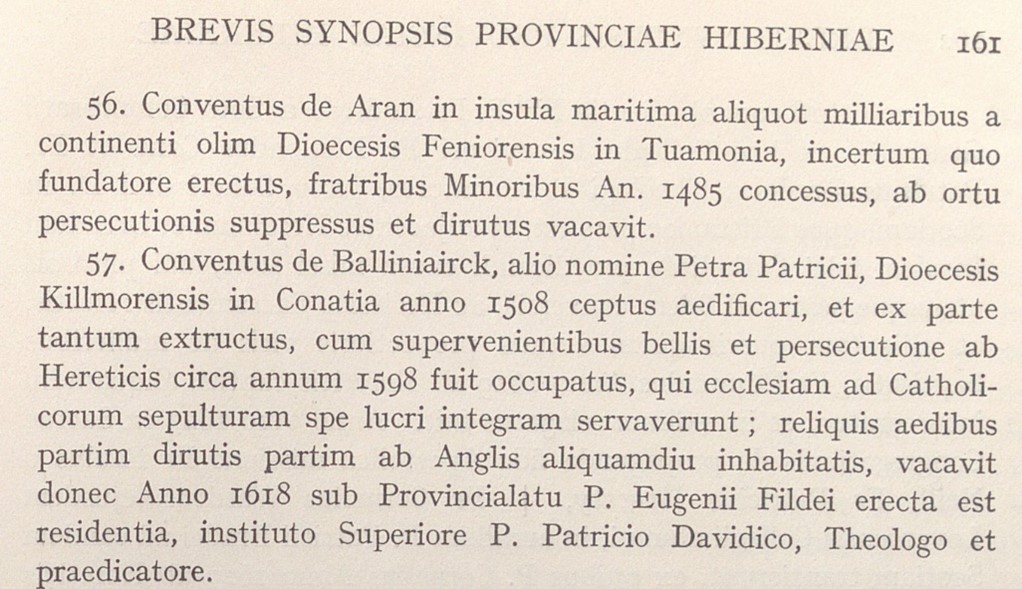

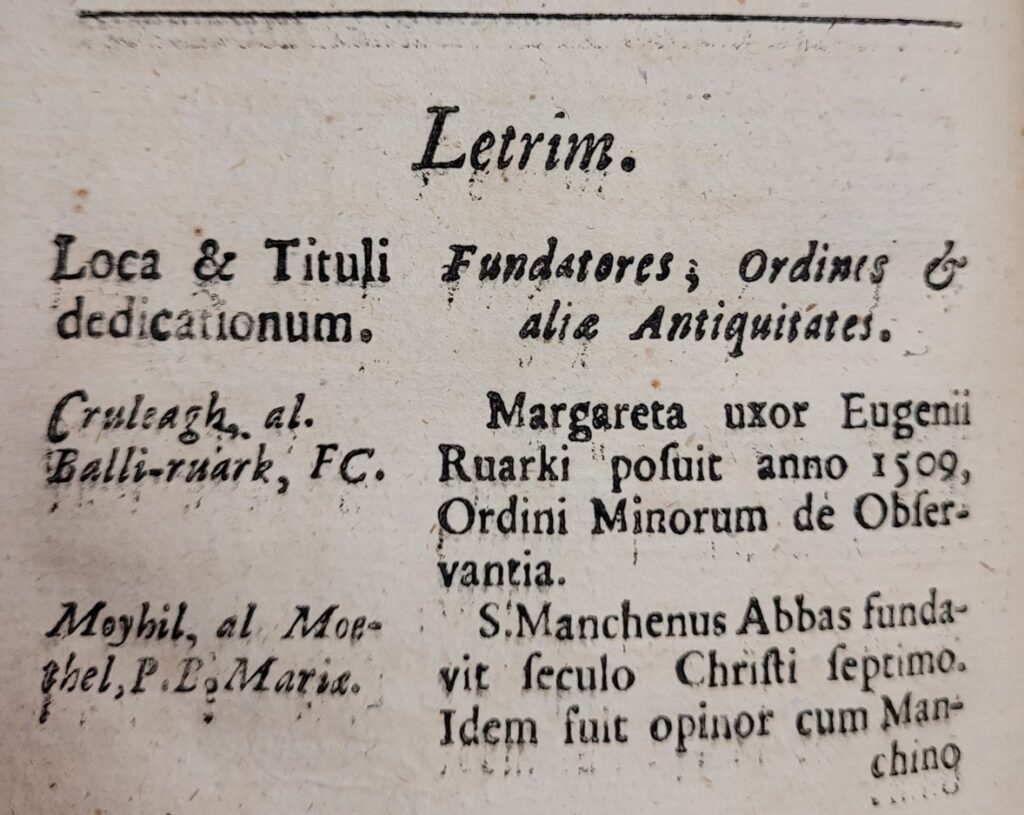
Some sources, on account of different names given to the friary (Creevelea, Balliniairck, Carrag Patrice or Petra Patrici), mention the friary as two or three separate locations. Such is the case with Mervyn Archdall’s (1723-1791) Monasticon Hibernicum that records the friary as two places: Balleguarcy founded in 1518 by Cornelius O’Brien and Creevelea founded in 1508 by Margaret O’Brien.

According to the Annals of Ulster, the friary was originally built as a wooden church. It was consecrated in 1511 by Thomas MacBrady, Bishop of Kilmore, who died at ‘Druim-da-ethiar—having gone to Breifny to consecrate a church’, as described by The Annals of the Four Masters. One year later, in 1512 Margaret O’Brien died and was buried in the friary; Eoghan O’Rourke died in 1528 and was also buried at the friary, wearing a Franciscan habit.

The friary was witness to turbulent events. As recorded in The Annals of the Four Masters and The Annals of Ulster, a murder occurred at the friary in 1532, when Eoghan O’Rourke was ‘slain by O’Mulvey and his kinsmen’. The same Annals record that in 1536 the friary burned down and two friars were killed in the fire.
The Brevis Synopsis records that Creevelea friary was occupied and pillaged by the English in 1598, although they allowed Catholic burials to continue in the friary grounds. Another house was built for the friars at Creevelea in 1618. Donatus Mooney (1577-1624), an Irish Franciscan Provincial and historian, in his History of the Franciscan Order in Ireland adds that the friary was occupied by an Englishman named Harrison. In 1603, an inquisition found that ‘the late warden was seized of seven rectories and lands.’
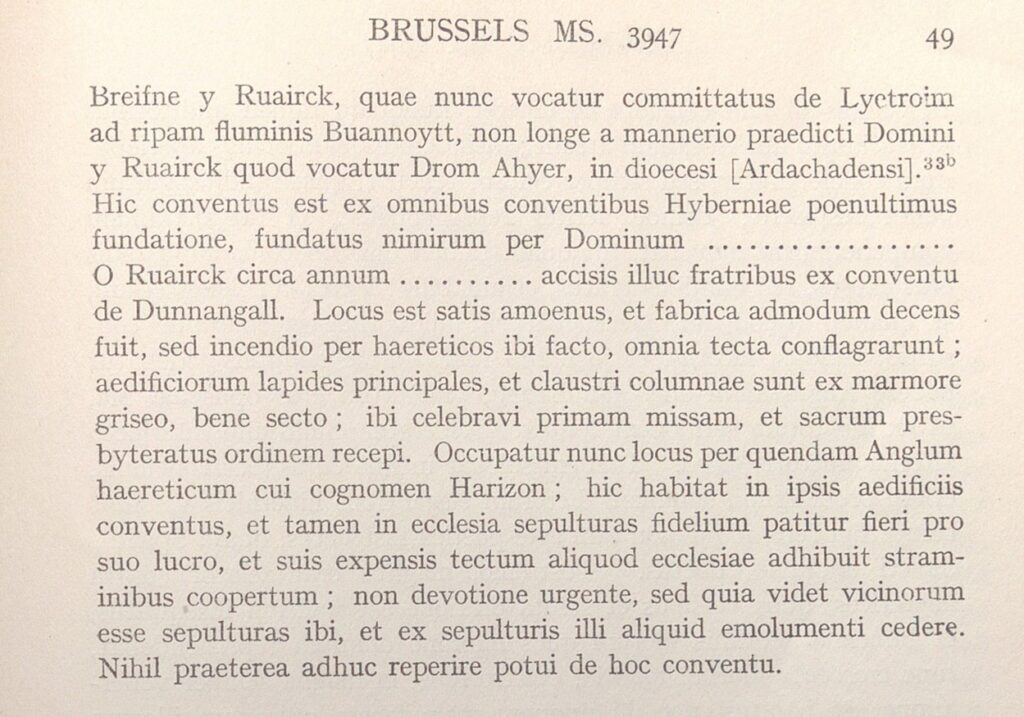
History of the Diocese of Ardagh, written by James J. McNamee and published in 1954, gives an overview of historical events at the friary from the sixteenth to the nineteenth centuries. After the friary burned down in 1536, it was restored by Brian Ballach O’Rourke. The friars returned to Creevelea friary in 1642 with the outbreak of the Irish Confederate Wars, only to abandon the friary in 1650 after Cromwellian victories. Despite this, guardians of Creevelea continued to be appointed at the Franciscan chapters for almost two centuries afterwards. The last recorded guardians of Creevelea were James Joyce, who was appointed in 1825, and Peter Magauran, who in 1834 attended the diocesan synod as ‘Pastor de Killanumera’.

The friary church and conventual buildings are still well preserved with a transept, a tower, a nave and a choir of the church largely intact. The remains of a large cloister, a chapter house, a scriptorium, a kitchen, a refectory and a sacristy are also present. Some of the windows retain their tracery. Several stone carvings in the friary are visible: a carving of a lily in the east window (possibly part of the Annunciation scene), plant motifs under the tower crossing, and two images of Saint Francis in the cloister, including Francis preaching to the birds and Francis showing the stigmata.
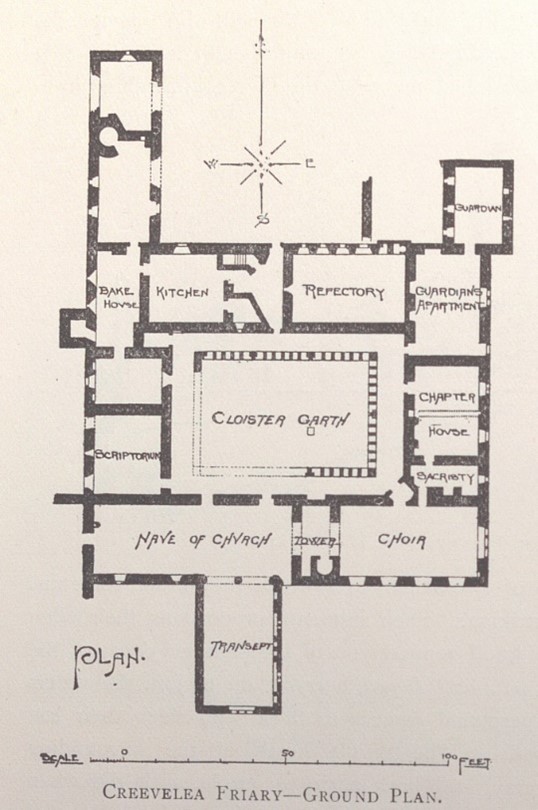
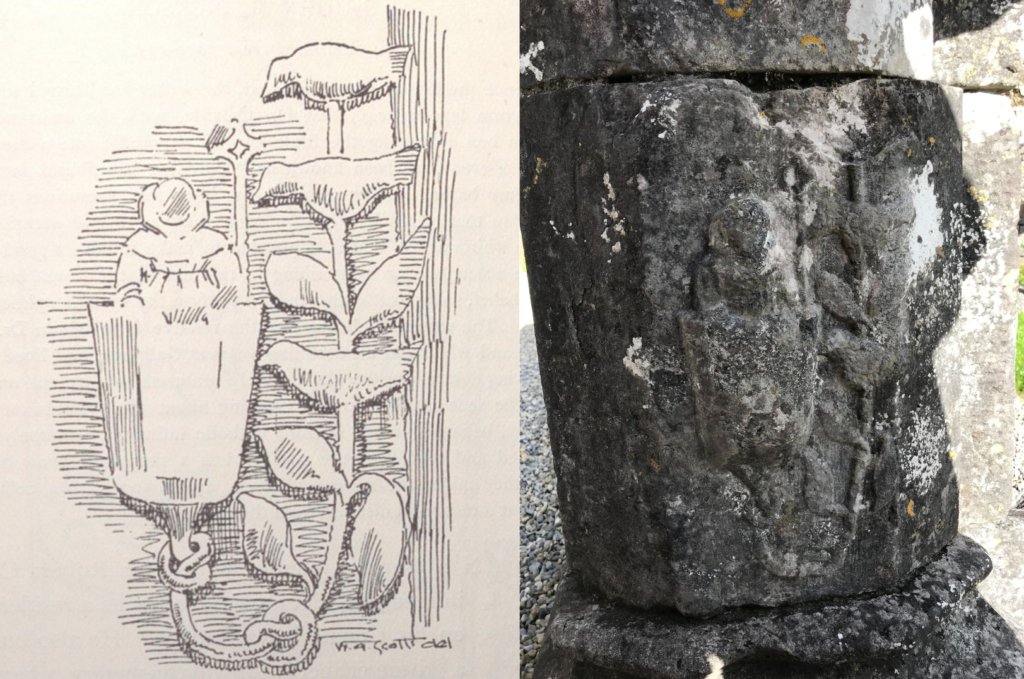
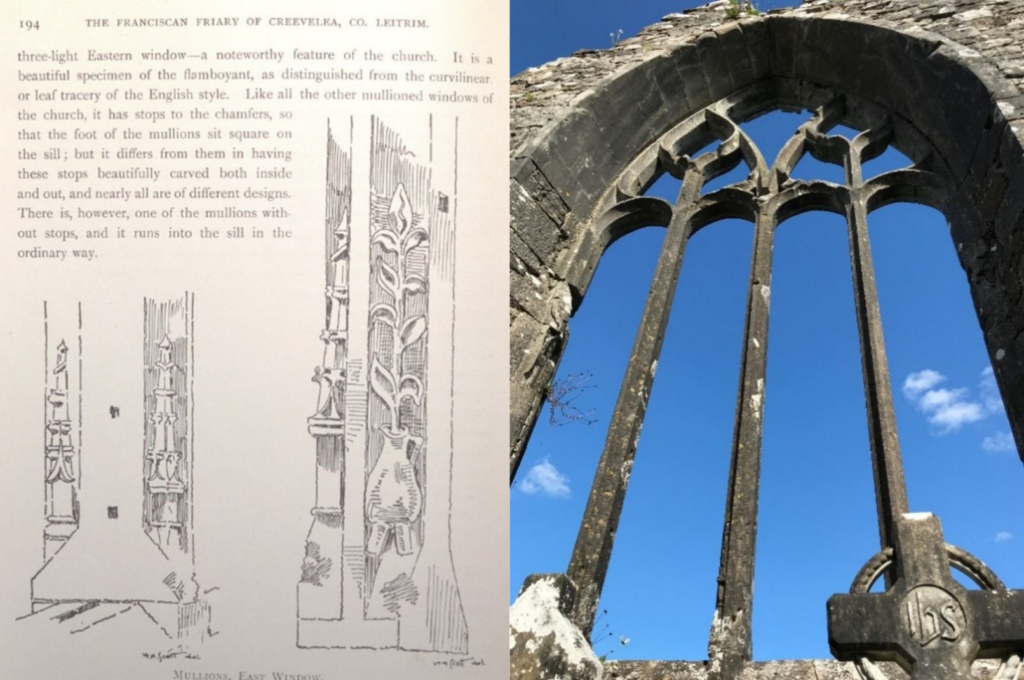
Right: Creevelea Franciscan friary, east window. Photo: Małgorzata Krasnodębska-D’Aughton.
Bibliography
- Archdall, Mervyn, Monasticon Hibernicum: Or, A History of the Abbeys, Priories, and Other Religious Houses in Ireland, London: Printed for William Mears at the Lamb without Temple-bar, 1786.
- Jennings, Brendan, ‘Donatus Moneyus, De Provincia Hiberniae S. Francisci’, Analecta Hibernica, vol. 6, 1934, pp. 12-138.
- –––, ‘Part II: Brevis Synopsis Provinciae Hiberniae FF. Minorum’, Analecta Hibernica, vol. 6, 1934, pp. 139-191.
- Lyons, Mary Ann, ‘The Onset of Religious Reform: 1460-1550’, in Brendan Smith, ed., The Cambridge History of Ireland: Volume 1, 600–1550, Cambridge: Cambridge University Press, 2018, pp. 498-522.
- MacCarthy, B., ed., Annals of Ulster: Otherwise, Annala Seanait; Annals of Senat/a Chronicle of Irish Affairs from A. D. 431, to A. D. 1540., vol. 3: 1379-1541, Dublin: A. Thom & Co. Ltd, 1887-1901.
- MacKenna, J. E. and Scott, W. A., ‘The Franciscan Friary of Creevelea, in the Barony of Breffny, Co. Leitrim’, Ulster Journal of Archaeology, vol. 5, no. 4, 1899, pp. 190–201.
- McNamee, James J., History of the Diocese of Ardagh, Dublin: Brown & Nolan, 1954.
- Moloney, Joseph, ‘Part III: Brussels MS. 3410: A Chronological List of the Foundations of the Irish Franciscan Province’, Analecta Hibernica, vol. 6, 1934, pp. 192–202.
- O’Donovan, John, ed. and transl., Annala Rioghachta Eireann: Annals of the Kingdom of Ireland by the Four Masters, Dublin: Hodges and Smith, 1851.
- Ware, James, De Hibernia et antiquitatibus eius, London: Typis J. Grismond, impensis Jo. Crook & Thomae Heath, 1654, p. 230.
Finbarr Nolan
